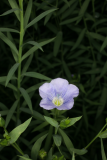Additional notes (click to expand)
Medicinal
Traditional Herbal Medicine Registration (THMR).
Linseed has a long history of medicinal use, its main effects being as a laxative and expectorant that soothes irritated tissues, controls coughing and relieves pain. The seed, or the oil from the seed are normally used. The seed is analgesic, demulcent, emollient, laxative, pectoral and resolvent.
Plants for a Future at www.plantsforafuture.org.uk http://www.pfaf.org/user/Plant.aspx?LatinName=Linum+usitatissimum
link
Other use
Cultivated since 8000BC for fibre and seed (source of linseed oil) The fibre is the source of linen, used for wrapping Eygptian mummies.
Phillips, R, Rix, M. (2002). The Botanical Garden vol 2. Macmillan. p.119
Podcast
Linum usitatissimum L.
Family: LINACEAEGenus: Linum
Species: usitatissimum L.
Common names: Flax; Linseed; Lin; Line
Pharmacopoeia Londinensis name: Linum
Distribution summary: Only cultivated
Habit: Annual
Hardiness: H5 - Hardy; cold winter
Habitat: Lowland, open woodland, grassland, scrub and verges
Garden status: Currently grown
Garden location: Pharmacopoeia Londinensis 1618 'Seeds & Grains' (HSE 8)
Flowering months: June
Reason for growing: Medicinal, traditional herbal registration
.JPG)
.JPG)
.JPG)
.JPG)

